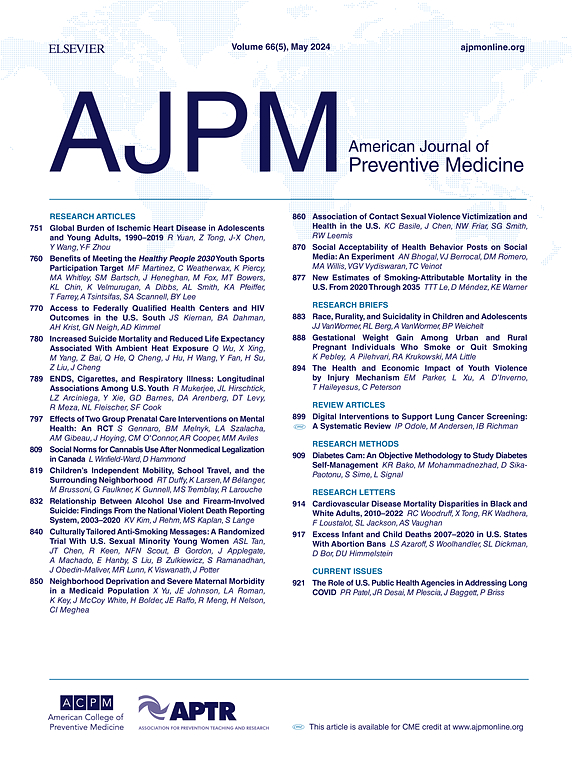Trends in Nonfatal Fentanyl Exposures Involving Stimulants in the United States, 2015–2023
IF 4.3
2区 医学
Q1 MEDICINE, GENERAL & INTERNAL
引用次数: 0
Abstract
Introduction
Fentanyl-related deaths involving stimulants have increased in the U.S., but little is known about nonfatal overdoses involving use. This study examined national trends in nonfatal fentanyl-related exposures involving co-use of cocaine or methamphetamine.
Methods
In this cross-sectional analysis, data from U.S. poison centers were used to estimate annual trends in reported exposures involving fentanyl and stimulant use from 2015 to 2023. Cases included patients aged ≥13 with exposures involving intentional misuse or “abuse” of fentanyl where nonfatal adverse effects occurred (n=13,173). Co-exposure trends were examined, and multivariable logistic regression models were used to estimate how region and medical outcome severity were associated with (1) fentanyl–cocaine use (versus fentanyl, no cocaine use) and (2) fentanyl–methamphetamine use (versus fentanyl, no methamphetamine use).
Results
Between 2015 and 2023, among fentanyl-related exposures, cocaine use increased from 1.3% to 10.0% (669.2% increase, p<0.001) and methamphetamine use increased from 1.5% to 10.8% (620.0% increase, p<0.001). Exposures in the Northeast were associated with higher odds of cocaine co-use, while exposures in the Midwest, South, and West were associated with higher odds of methamphetamine co-use. Compared to those with less severe effects, those with a major (life-threatening) effect had higher odds of cocaine co-use, but lower odds of methamphetamine co-use.
Conclusions
Similar to drug-related mortality trends, nonfatal fentanyl poisonings involving co-use of cocaine or methamphetamine increased in recent years and became increasingly widespread. Differences in experience of life-threatening adverse effects linked to different stimulants suggests varying risk according to which stimulant is involved.
2015-2023年美国涉及兴奋剂的非致命性芬太尼暴露趋势
在美国,与芬太尼相关的兴奋剂死亡人数有所增加,但对芬太尼非致命性过量使用的情况知之甚少。我们研究了全国非致命性芬太尼相关暴露的趋势,包括可卡因或甲基苯丙胺的共同使用。方法:在本横断面分析中,使用来自美国毒物中心的数据来估计2015年至2023年报告的芬太尼和兴奋剂使用的年度趋势。病例包括年龄≥13岁的患者,涉及故意误用或“滥用”芬太尼,发生非致命性不良反应(n=13,173)。研究了共暴露趋势,并使用多变量logistic回归模型来估计区域和医疗结果严重程度与(1)芬太尼-可卡因使用(相对于芬太尼,不使用可卡因)和(2)芬太尼-甲基苯丙胺使用(相对于芬太尼,不使用甲基苯丙胺)之间的关系。结果:2015年至2023年间,在芬太尼相关暴露中,可卡因使用量从1.3%增加到10.0%(增幅为669.2%)。结论:与药物相关死亡率趋势相似,近年来涉及可卡因或甲基苯丙胺的非致命性芬太尼中毒增加,并变得越来越普遍。与不同兴奋剂相关的危及生命的不良反应的经验差异表明,兴奋剂所涉及的风险不同。
本文章由计算机程序翻译,如有差异,请以英文原文为准。
求助全文
约1分钟内获得全文
求助全文
来源期刊

American Journal of Preventive Medicine
医学-公共卫生、环境卫生与职业卫生
CiteScore
8.60
自引率
1.80%
发文量
395
审稿时长
32 days
期刊介绍:
The American Journal of Preventive Medicine is the official journal of the American College of Preventive Medicine and the Association for Prevention Teaching and Research. It publishes articles in the areas of prevention research, teaching, practice and policy. Original research is published on interventions aimed at the prevention of chronic and acute disease and the promotion of individual and community health.
Of particular emphasis are papers that address the primary and secondary prevention of important clinical, behavioral and public health issues such as injury and violence, infectious disease, women''s health, smoking, sedentary behaviors and physical activity, nutrition, diabetes, obesity, and substance use disorders. Papers also address educational initiatives aimed at improving the ability of health professionals to provide effective clinical prevention and public health services. Papers on health services research pertinent to prevention and public health are also published. The journal also publishes official policy statements from the two co-sponsoring organizations, review articles, media reviews, and editorials. Finally, the journal periodically publishes supplements and special theme issues devoted to areas of current interest to the prevention community.
 求助内容:
求助内容: 应助结果提醒方式:
应助结果提醒方式:


